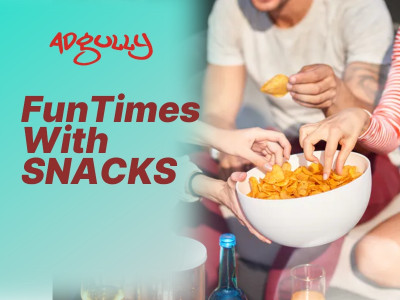Growing appetite for snacks - who gets a bigger bite of the market?
The snacking market in the last one decade has made a rapid change and progress. The category has seen lot of action in the last couple of years and has a huge potential to grow. Companies and brands with strong marketing and distribution strength and who are able to bring in innovative product offerings to delight the customers will be able to withstand the competition and grow their business as the category is in its growth trajectory.
Presence of multiple brands
The salted snack market has been growing even as there is a growing move among Indians to stay fit and healthy. There is a huge appetite for ready-to-eat snacks and products. The demand for such snacks grew even further due to the pandemic, when most people were working from homes. While there are many local brands which cater to the regional markets, several big players are also making deep inroads, such as ITC Foods, Haldiram, Pepsi, Parle, Balaji, Prataap Snacks, among others. Recently, Mondelez entered this market with a test market launch in Delhi with their brand Trisbix, a flavoured cracker. This is a pilot launch that company has tried out for the first time although in the past Mondelez has launched biscuits apart from chocolates, which has been their core business for decades in India.
Marketing Opportunity
Interestingly Mondelez gets about 70% of its sales from non-chocolate portfolio such as biscuits, gums, candies and beverages while in India chocolates account for a bulk of its sales. In India, the company entered several categories including cakes and breakfast cereals since last year they had earlier launched Oreo which was well received in the market. This will be an interesting launch for Mondelez as the total salty snack market is estimated at Rs. 35,000 crores with a healthy growth rate of over 20%. In a fiercely competitive snack market, the market is strongly driven by price, with a variety of product offerings. Pricepoint as low as Rs. 5/- is what that is being offered by some of the brands to generate quick trials especially in the smaller markets which is price sensitive. The health-based snack products are also growing. The health snacks sub-segment is estimated to be around 2% of the overall snacks market.
Perfect Product Presentation
The product and packaging play a key role for a robust brand to succeed. Attractive, colourful and innovative packaging needs to be designed and created for the product to stand out in the crowded retail space. The Indian consumer will never compromise on taste. Their expectations from snacky products have evolved over a period of time so they keep expecting and exploring unique and tasty flavour combinations. While,when brands focus only on taste the health quotient gets reduced but some of the brands keep inventing by providing unique flavours with additional health and nutritional ingredients by reducing salt and adding vitamin supplements. They also keep in mind the local and regional markets where they offer the local and regional flavours to meet the local taste and catch the local population.
Right Positioning & Communication
The communication strategy and advertising has got a lot to play a very important role to differentiate the product with some interesting and unique positioning and catchy slogans. Since the differentiation is thin in this busy category, getting into the consumer’s mind and staying top of mind will always be challenge. Since the brands are targeted to the younger audience and is youth centric it is the irresistible taste and the mind-blowing flavours that has been attracting the customers. Most brands try to use humour as the approach but some of the brands have tried to amplify the emotional attributes of the brand by narrating the story strongly and bringing that distinct connect with the audience with lot of fun elements into their campaigns. The use of celebrities has also worked favourably for the brands. Both Bollywood and cricketing celebrities are leveraged to gain the maximum advantage to sell the brands and engage with their audience. Finally, it is the unique product taste, price advantage and strong and innovative distribution and the right positioning is what helping brands to grow and sustain it.
Prataap Snacks Ltd. has been an enterprising brand from Indore who has made deep inroads into the snack market. Speaking to Adgully, Amit Kumat, MD and CEO of Prataap Snacks Ltd, said that “The Indian salty snack category has a very large market potential, with rising consumption of packaged foods, increasing disposable income and changing lifestyle. On top of that, the shift from the unorganized to the organized sector will be taking place at a much faster rate due to increased consumer consciousness of hygiene because of the pandemic. As a well-established organised player in the industry, with a loyal customer base and a robust distribution network, we are well placed to take advantage of this opportunity and continue to enjoy strong demand. We have a very deep understanding of customer preferences, which gives us a competitive edge in all our markets across the country. We focus on the three important elements that are most important for growth in the industry, namely product range, taste and price. Our brand also has a well-diversified portfolio and we have forged excellent relations with distributors which has helped us to further strengthen our market position. On the communication front we focus on taste and value proposition we offer. Our approach has been very customer centric and we are present across all communication channels.”
Food preferences and consumption trends have evolved in the last year, especially during the ongoing pandemic. Sharing her views, Shailja Joshi, Director - Marketing, Potato Chips Category, PepsiCo India, remarked that consumers switched to working from home and celebrating moments of togetherness at home which was a major upwards driver for consumer snacking.
Consumers began to closely look at value for money and flavour while making purchasing decisions. To remain differentiated in the market, Lay’s introduced unique flavours - Herby Crush and Cheesy Love and connected them with the popular occasion of Valentine’s Day earlier this year. Along with flavours, an extensively engaging campaign - #YehWaalaYaadRahega – was brought to Indian millennials. Providing value for money, while leveraging the uptick in at-home consumption, Lay’s launched ‘@ Home’ packs to be the perfect companions for our consumers in all their experiences ‘at home’ – be it work or leisure.
Continuing further, she said that their strategy for Lay’s over the last year was guided by the fact that consumers were gravitating towards brands that outrightly communicated a ‘Solve, Not Sell’ attitude and lead with purpose in these challenging times. Hence our plans worked towards bringing joy as well as value to our consumers. These insights were at the heart of our Lay’s Heartwork campaign, Lay’s @ Home packs, #YehWaalaYaadRahega campaign and PepsiCo X Airtel Promo Packs.
The Indian snack industry is at a point where snacks are taking preference over everything else. Krishnarao Buddha, Senior Category Head, Parle Products, who has been closely involved in this category said that the rise of work-from-home and remote-schooling culture ever since the COVID-19 pandemic hit has simultaneously led to a rise in snacking frequency, especially among younger consumers. Consumers have become accustomed to having more snacks today.
“Having said that, the segment has become extremely lucrative. Of late, we are seeing a resurgence in product development and more players entering the market to encash on the growing consumer interest in snacks. Owing to demand, there is also room to increase the penetration of salty snacks in the country which is around only 65% indicating there is a huge opportunity. That is the key reason why we are seeing many big brands entering into the snacking industry. Earlier the major brands in snacking were Haldiram’s and PepsiCo. However, now we see brands like ITC and strong regional brands like Balaji Wafers & Yellow Diamond making the entire category extremely competitive,” Buddha added.
Firstly, a differentiated product serves as a USP in this category and is appreciated as well as well-received by consumers. For instance, there's not much to differentiate in potato chips but we introduced a unique flavour - ‘Piri-Piri’, which was well received by the consumers.
The second is basis the product offering making a regional product a national hit. For instance, we used ‘Sev Murmura’, which is mostly a regional snack and scaled it nationally which got accepted quite well. The product has been a success which has received an overwhelming response.
According to Buddha, “A differentiated communication strategy works best in case of non-differentiated product offering. We need to capture relevance and give consumers a strong reason to buy the product. As far as the food category is concerned, strategic communication is key, which needs to be supported with a well-balanced marketing mix comprising of the 4P’s.”









Share
Facebook
YouTube
Tweet
Twitter
LinkedIn